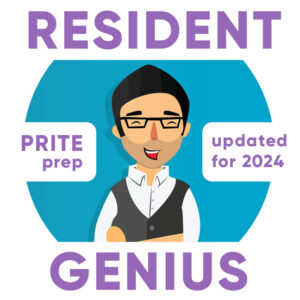
The PRITE, which stands for the Psychiatry Resident-In-Training Examination, is an annual exam taken by psychiatry residents in the United States. This examination is designed to assess the general psychiatric knowledge of residents at various stages of their training. It covers a wide range of topics within psychiatry, including neurology, psychopathology, psychopharmacology, neurodevelopment, and other relevant fields.
The results of the PRITE are used by residency programs to gauge the progress of their residents, identify areas where improvement might be needed, and prepare residents for the American Board of Psychiatry and Neurology (ABPN) certification exam. Let’s take a look at the 2024 PRITE blueprint:
Here is the overview of the exam:
| Highlights | Number of Questions | Percentage |
|---|---|---|
| Total Number of Questions | 300 | 100% |
|
Clinical Neurosciences |
69 | 23% |
|
Clinical Neurology |
30 | 10% |
|
Clinical Psychiatry |
201 | 67% |
A. Clinical Neurosciences (69 Questions)
- Neurodevelopment
- Neuroanatomy
- Neurophysiology
- Genetics
- Epigenetics
- Types of genetic abnormalities
- Methods to identify genes and genetic disorders
B. Clinical Neurology (30 Questions)
- Diagnostic procedures
- Neuroimaging
- Neurophysiological testing for neurological evaluation
- Diagnostic and clinical evaluation of neurologic disorders/syndromes
- Common neurological disorders/syndromes
- Comorbid psychiatric disorders
- Management and treatment of neurological disorders/syndromes
C. Clinical Psychiatry (200 Questions)
Development and Maturation across the Lifespan (30 Questions)
- Physical, Cognitive, Social, Sexual, Life transitions and environmental influences
Behavioral and Social Sciences (15 Questions)
- Psychology
- Behavioral/Cognitive psychology
- Neuropsychology/Learning theory
- Psychoanalytic/Psychodynamic theory
- Social psychology/Sociology/Anthropology/Ethnology
- Other behavioral/social sciences
Epidemiology (9 Questions)
- Core concepts and major research studies
- Prevention and risk factors
-
Other epidemiology
Diagnostic Procedures (15 Questions)
- Interview
- Mental Status
- Diagnostic assessments and rating scales
- Psychological/Neuropsychological testing
- Laboratory testing/Monitoring
- Imaging
- Neurophysiological testing (eg. Sleep, EEG, EMG)
Psychopathology and Associated Conditions Across the Lifespan (39 Questions)
- Disorders (eg. Anxiety, Bipolar, ADHD, Sleep-wake, Personality etc.)
- High-Risk Behaviors
- Environmental Factores
Treatment across the Lifespan (45 Questions)
- Patient Engagement
- Case Formulation/Differential Diagnosis/Treatment Planning
- Management of difficult patients and nonadherence to treatment
- Somatic Therapies
Consultation and Collaborative-Integrated Care (10 Questions)
Issues in Practice (20 Questions)
- Quality improvement/Patient safety/Risk management/Use of Technology
- Ethics/Professionalism
- Forensics/Legal issues
- History of psychiatry
Research and Scholarship Literacy (9 Questions)
- Research design/Methods
- Accessing/Evaluating/Applying evidence to practice
- Statistics
Administration and Systems (9 Questions)




